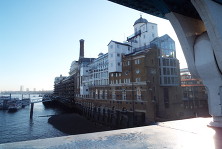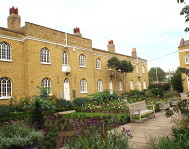








Camberwell Hall
Camberwell Hall is a fine Georgian building in Grove Lane that bears a plaque inscribed with the date 1748. It was originally built as the assembly room for the Grove House Tavern, a popular place of entertainment with extensive gardens, the Camberwell Tea Gardens that were well attended by “the lads and lasses of London Town.” Not known as Camberwell Hall until the middle of the 19th century, it was a venue for balls and concerts, and quickly became the social
hub for the middle classes in Camberwell at a time when it was surrounded by market gardens and open fields. It was where the Camberwell Club met in the middle of the eighteenth century, an exclusive club whose membership comprised the great and the good of Camberwell – clergyman, lawyers, merchants, not to mention the local landowners – who met for quarterly feasts and snug dinners.
On 20 September 1821, an advert appeared in the classified section of The Times announcing the sale of a lease for 31 years of “the highly respectable and well known premises, called the Grove-house”. The lease was being sold by Mr John Monkhouse who was quitting the business. A look at the details shows how extensive the premises were. There were “spacious assembly, ball and dinner rooms capable of dining 800 persons, bowling green, gardens and premises, with a detached tap, that has a most excellent porter trade … stableyard, stables, coachhouses, and extensive premises which are let off.”
Mr Monkhouse was still the proprietor on New Year’s Eve when a large assembly was held. James Ellis, described as no more than a lad, was found guilty of stealing four teaspoons used at this event. He had previously worked at Grove House but, though discharged, had been allowed to continue to live on the premises until he could provide for himself. He had pawned the four teaspoons to raise money for his mother who lay sick in the workhouse. Despite a strong recommendation of mercy from Mr Monkhouse, James was sentenced to seven years transportation. A very sad story, it was reported that James cried bitterly through the trial.
Concerts, lectures, political meetings and sometimes parochial matters such as inquests continued to be held in the assembly room. In September and October 1829 Madame Tussaud exhibited her waxworks there just prior to taking up her permanent venue in ‘The Baker Street Bazaar’, and in August 1842, Mr Donovan, the principal of the London Phrenological Institution gave lectures on phrenology.
Some time in the middle of the 19th century, the assembly room and the tavern became separate enterprises. The Grove House tavern maintained its frontage on Camberwell Grove, where the tall terraced houses that are there today had been built. The assembly room, on the land behind the tavern, fronted onto Grove Lane and renamed Camberwell Hall. Lectures continued to be given including those on German Literature, Ancient Art and Geography in Europe given by Dr Kinkel and a concert performed by the English Glee and Opera Union. The Times of 15 April 1858 announced Camberwell Hall would host “The celebrated Color’d Opera Troupe (eight in number) [who] will hold their concerts of refined Negro music and character”.
***
Today Camberwell Hall is private apartments. The tavern, though built in mock Queen Anne style, looks like it was built in the first half of the 20th century, but that's a guess. It maintained its original name, the Grove House Tavern until about 2005 when it became part of chain of London pubs and renamed the Grand Union.
Web discoveries
- UK Casino Not On Gamstop
- UK Casino Not On Gamstop
- Non Gamstop Casino
- Casinos Not On Gamstop
- Non Gamstop Casinos
- Non Gamstop Casinos
- Non Gamstop Casino
- Casino Sites Not On Gamstop
- Slots Not On Gamstop
- Casinos Not On Gamstop
- UK Betting Sites Not On Gamstop
- UK Casino Not On Gamstop
- Best Non Gamstop Casinos
- Betting Sites
- Non Gamstop Casino Sites UK
- Best Non Gamstop Casinos
- Non Gamstop Casino
- Casinos Not On Gamstop
- Non Gamstop Casino Sites UK